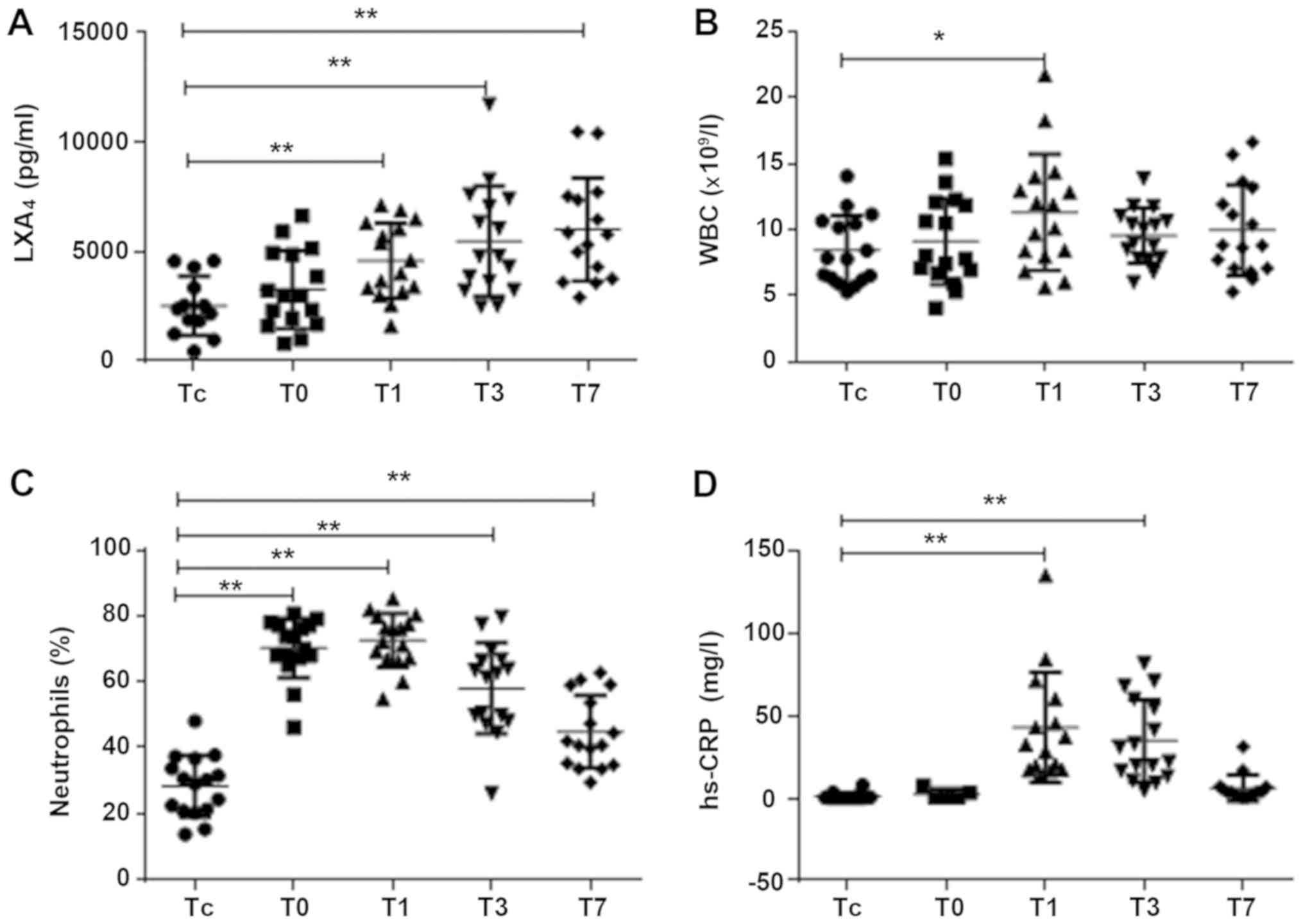|
1
|
Cremer J, Martin M, Redl H, Bahrami S,
Abraham C, Graeter T, Haverich A, Schlag G and Borst HG: Systemic
inflammatory response syndrome after cardiac operations. Ann Thorac
Surg. 61:1714–1720. 1996. View Article : Google Scholar : PubMed/NCBI
|
|
2
|
Weerasinghe A, Athanasiou T, Philippidis
P, Day J, Mandal K, Warren O, Anderson J and Taylor K:
Platelet-monocyte pro-coagulant interactions in on-pump coronary
surgery. Eur J Cardiothorac Surg. 29:312–318. 2006. View Article : Google Scholar : PubMed/NCBI
|
|
3
|
Paśnik J, Siniewicz K, Moll JA, Moll J,
Baj Z, Sysa A and Zeman K: Effect of cardiopulmonary bypass on
neutrophil activity in pediatric open-heart surgery. Arch Immunol
Ther Exp (Warsz). 53:272–277. 2005.PubMed/NCBI
|
|
4
|
Hu F, Feng AP, Liu XX, Zhang S, Xu JT,
Wang X, Zhong XL, He MW and Chen HX: Lipoxin A4 inhibits
lipopolysaccharide-induced production of inflammatory cytokines in
keratinocytes by up-regulating SOCS2 and down-regulating TRAF6. J
Huazhong Univ Sci Technolog Med Sci. 35:426–431. 2015. View Article : Google Scholar : PubMed/NCBI
|
|
5
|
Börgeson E, McGillicuddy FC, Harford KA,
Corrigan N, Higgins DF, Maderna P, Roche HM and Godson C: Lipoxin
A4 attenuates adipose inflammation. FASEB J. 26:4287–4294. 2012.
View Article : Google Scholar : PubMed/NCBI
|
|
6
|
Lv W, Lv C, Yu S, Yang Y, Kong H, Xie J,
Sun H, Andersson R, Xu D, Chen B, et al: Lipoxin A4 attenuation of
endothelial inflammation response mimicking pancreatitis-induced
lung injury. Exp Biol Med (Maywood). 238:1388–1395. 2013.
View Article : Google Scholar : PubMed/NCBI
|
|
7
|
Ryan A and Godson C: Lipoxins: Regulators
of resolution. Curr Opin Pharmacol. 10:166–172. 2010. View Article : Google Scholar : PubMed/NCBI
|
|
8
|
Wu B, Walker J, Spur B, Rodriguez A and
Yin K: Effects of Lipoxin A4 on antimicrobial actions of
neutrophils in sepsis. Prostaglandins Leukot Essent Fatty Acids.
94:55–64. 2015. View Article : Google Scholar : PubMed/NCBI
|
|
9
|
Wu B, Walker JA, Temmermand D, Mian K,
Spur B, Rodriguez A, Stein TP, Banerjee P and Yin K: Lipoxin A(4)
promotes more complete inflammation resolution in sepsis compared
to stable lipoxin A(4) analog. Prostaglandins Leukot Essent Fatty
Acids. 89:47–53. 2013. View Article : Google Scholar : PubMed/NCBI
|
|
10
|
Reina-Couto M, Carvalho J, Valente MJ,
Vale L, Afonso J, Carvalho F, Bettencourt P, Sousa T and
Albino-Teixeira A: Impaired resolution of inflammation in human
chronic heart failure. Eur J Clin Invest. 44:527–538. 2014.
View Article : Google Scholar : PubMed/NCBI
|
|
11
|
Dmitrieva VA, Samuilova DSh, Putiato NA
and Khurges IS: The role of immunological studies in the diagnosis
of bacterial endocarditis in patients with congenital heart
defects. Vestn Khir Im I I Grek. 149:147–151. 1992.(In Russian).
PubMed/NCBI
|
|
12
|
Serhan CN, Hamberg M and Samuelsson B:
Lipoxins: Novel series of biologically active compounds formed from
arachidonic acid in human leukocytes. Proc Natl Acad Sci USA.
81:5335–5339. 1984. View Article : Google Scholar : PubMed/NCBI
|
|
13
|
Cattaneo F, Parisi M and Ammendola R:
Distinct signaling cascades elicited by different formyl peptide
receptor 2 (FPR2) agonists. Int J Mol Sci. 14:7193–7230. 2013.
View Article : Google Scholar : PubMed/NCBI
|
|
14
|
Saito J, Hashiba E, Mikami A, Kudo T, Niwa
H and Hirota K: Pilot study of changes in presepsin concentrations
compared with changes in procalcitonin and c-reactive protein
concentrations after cardiovascular surgery. J Cardiothorac Vasc
Anesth. 31:1262–1267. 2017. View Article : Google Scholar : PubMed/NCBI
|
|
15
|
Svensson AS, Kvitting JP, Kovesdy CP,
Cederholm I and Szabó Z: Changes in serum cystatin C, creatinine,
and C-reactive protein after cardiopulmonary bypass in patients
with normal preoperative kidney function. Nephrology. 21:519–525.
2016. View Article : Google Scholar : PubMed/NCBI
|
|
16
|
Dillenseger L, Langlet C, Iacobelli S,
Lavaux T, Ratomponirina C, Labenne M, Astruc D, Severac F, Gouyon
JB and Kuhn P: Early inflammatory markers for the diagnosis of
late-onset sepsis in neonates: The Nosodiag Study. Front Pediatr.
6:3462018. View Article : Google Scholar : PubMed/NCBI
|















